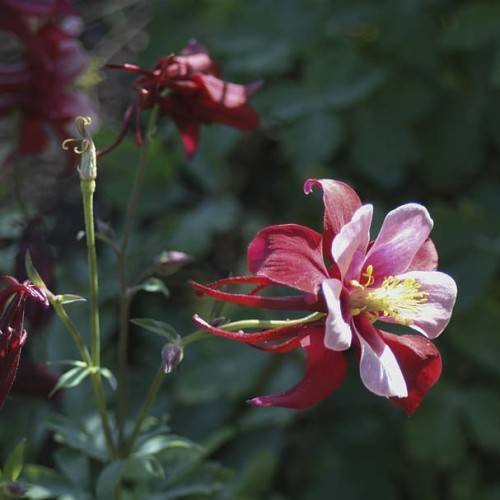
columbine
Aquilegia caerulea 'Rotstern'
Cycle:
Herbaceous Perennial
Watering:
Average
Hardiness Zone:
3 - 8
Flowers:
Flowers
Sun:
Full sun,part shade
Leaf:
Yes
Growth Rate:
Low
Maintenance:
Moderate
Care Level:
Medium
watering
Columbine should be watered regularly but not over-saturated. Keep the soil slightly moist by watering deeply once every 7 to 10 days during the plant's growing season (spring and summer). During the autumn and winter periods, when the plant is dormant, watering should only take place in periods of extended dryness. Water deeply enough to saturate the soil but avoid overwatering, as this could damage the roots.
sunlight
Columbine (Aquilegia caerulea 'Rotstern') should receive at least 6 hours of direct sunlight each day in order to grow and thrive. They are not particularly picky when it comes to the timing of this sunlight—it can be morning, afternoon, or a combination of the 2. However, try to avoid giving columbine direct midday sun, as it can be intense and cause damage to the plants. When the temperature rises in the warmer months, ensure columbine is being provided with afternoon shade to provide relief from the heat.
pruning
Columbine (Aquilegia caerulea 'Rotstern') should be pruned in late winter or early spring. The plant should be pruned back by approximately 1-half, removing any dead, spindly, or damaged portions of the plant. Take care to not cut healthy foliage. If an overall shape of the plant is desired, thin-out individual branches to reduce the overall size and improve air circulation to reduce fungal problems. To keep the plant orderly, remove dead flower stems as they appear. Additionally, removing the flower heads before they go to seed will help to prevent spreading.
Season
Hardiness Map
FAQ
Is columbine a perennial flower?
Yes, columbine is a perennial flower that blooms in early spring and can often re-bloom through autumn. It grows quite well in full sun or part shade and thrives in well-drained soil. It's a great choice for adding some cheerful colour to your beds and borders with its intricate blooms of pastel hues. Columbine is also quite a resilient flower and does relatively well in colder climates.
Are columbine flowers suitable for rock gardens?
Yes, columbine flowers are suitable for rock gardens. Columbine tend to flourish in sunny rock gardens with good drainage and soil that isn't too rich. They prefer rocky, well-draining soils and need little or no supplemental watering, making them ideal for rock gardens. The flowers of columbine usually bloom once in the spring and then again in the fall. The blooms of most columbine species come in combinations of pink, white, yellow, purple, and blue. Planting several varieties of columbine together in a rock garden can give you a beautiful, show-stopping display.
Could columbine flowers be used as ground cover?
Columbine flowers can be used as ground cover in certain situations. They are relatively easy to grow, and tall varieties will generally give you a nice low-maintenance spread of foliage, although they can tend to be a bit sparser than more conventional ground covers. Columbine also has the advantage of producing a beautiful array of colors such as blues, purples, yellows, and more. When planted in large groups and in the right situation they can even bring about a beautiful carpet of blooms. It’s important to be aware that columbine is an aggressive self-seeder, so if you don’t want lots of columbine in other areas of your garden you might want to deadhead the flowers or grow it in a container.
Is columbine a good companion plant for roses?
Yes, columbine is an excellent companion plant for roses. Columbine's delicate blooms and attractive foliage provide a wonderful contrast for roses, while their unassuming habit and relatively shallow root system won't compete with the more aggressive roots of roses. The shade of the columbine's foliage also helps to protect roses from the intense heat of direct sun, keeping them lusher and more vibrant in appearance. Additionally, columbine's brightly colored blooms make a perfect backdrop for roses, bringing out their colorful petals in an eye-catching display.
Do columbine flowers self-seed easily?
Yes, Columbine flowers self-seed easily. These plants have a natural capacity to propagate themselves by reseeding in surrounding areas and growing new plants each year. This is why they are often considered to be a natural garden perennial. As the flowers are pollinated, they form seed pods which are dropped as the seeds mature and are then spread around the plant. The fact that the Columbine flower is capable of self-seeding is beneficial to gardeners as it reduces the need to replant them each season, resulting in a fuller and more vibrant garden.
Is columbine a good choice for pollinator gardens?
Yes, columbine is a great choice for pollinator gardens. Having tall, showy flowers that come in a variety of colors, columbine attracts many pollinators, including bees, hummingbirds, and butterflies. The large blooms also provide ample nectar for pollinators to feed on. Meanwhile, the leaves of the columbine are also edible and can provide food for caterpillars, which will in turn attract more pollinators. Finally, columbines are easy to grow in shady areas and can easily be incorporated into garden beds or along garden paths. All in all, columbine is an excellent choice for pollinator gardens.
Are columbine flowers suitable for vertical gardening?
Yes, columbine flowers are suitable for vertical gardening. Not only are they capable of tumbling down a wall or spilling out of a hanging basket, but they also provide a dramatic pop of color to any living wall installation, from a tiny backyard wall garden to a spacious rooftop oasis. Low-maintenance and relatively easy to propagate, columbine flowers can create an eye-catching focal point in a vertical garden.
